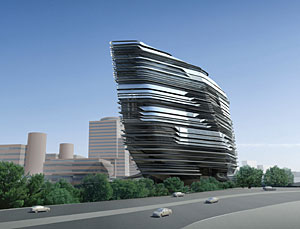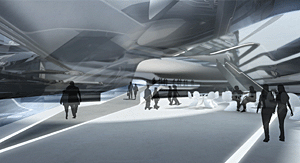Can an iconic new building by a world-renowned architect boost the global profile of an already well-regarded higher education institution? Officials at the Hong Kong Polytechnic University hope so. Last week they unveiled the competition-winning design by London-based Zaha Hadid for an interdisciplinary hub that will be home to its school of design, which BusinessWeek ranked among the top 60 worldwide in 2006. She beat out SANAA, of Japan, and Sauerbruch Hutton Architects, of Germany, to win the commission.


The shape of Hadid’s new tower for the Hong Kong Polytechnic University is reminiscent of a ship; the building is located near a cross-harbor tunnel. Inside, to heighten transparency, the column-free floors will feature glass walls.
Tentatively called “Innovation Tower,” Hadid’s 130,000-square-foot complex is made of two adjoining buildings, each with a rugged facade resembling a cliff face. This sculptural structure will use its dynamic exterior to project creative energy. Mostly made of transparent but tinted glass, the curtain wall will be shielded in parts by polished metal louvers that suggest the effect of an ocean liner in motion; fittingly, the campus is sited near the entrance to the city’s main cross-harbor tunnel. The $51 million project will be mostly funded by the local government and is expected to break ground by 2009.
The building’s fluidity of form—a hallmark of Hadid’s work—is employed here for the pragmatic goal of fostering collaborations across research labs and academic programs in digital media, advertising design, industrial design, and interior design. Lower levels will house exhibition spaces, communal areas, and a design museum—all to be seamlessly connected as a column-free whole. Some of the classrooms and lecture halls on the upper floors will be enclosed in glass. “The open interior allows creative energy to jump across,” says Lorraine Justice, a Pittsburgh native who heads the design school.
Located on a 1.3-acre site, currently occupied by a basketball court, the 12-story tower will feature a boomerang-shaped entrance that jabs into the surrounding landscape, creating intimate courtyards to draw in students from other departments. “There is an attempt in this design to make the school part of a wider design culture on campus,” says Patrik Schumacher, director of Zaha Hadid Architects.
Hadid is no stranger to designing for the terrains of Hong Kong. She had the first major break of her career in 1972, when she won a competition to design an apartment complex and sports club on the Victoria Peak, the city’s most popular sightseeing spot. But her futuristic design, envisioned as a horizontal skyscraper sweeping down the hillside, was deemed un-buildable and was never executed. “[The willingness to embrace innovations] has come a long way” over the past quarter-century, Hadid said a press conference last week. “The idea that it is impossible... has changed.”


Post a comment to this article
Report Abusive Comment